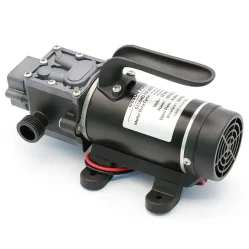Here are key features and characteristics associated with diaphragm booster pumps
2024-01-09
Diaphragm booster pumps are a type of positive displacement pump that uses a flexible diaphragm to move fluid. These pumps are commonly used in various applications, including water supply systems, agriculture, and industrial processes. Here are key features and characteristics associated with diaphragm booster pumps:
1. Working Principle:
- Diaphragm booster pumps operate on the principle of positive displacement. A flexible diaphragm, typically made of rubber or other elastomeric materials, is moved back and forth to create a pumping action.
2. Diaphragm Design:
- The diaphragm separates the pumped fluid from the moving parts of the pump, preventing direct contact between the fluid and the pump mechanism. This design makes diaphragm pumps suitable for handling a wide range of fluids, including corrosive and abrasive substances.
3. Single and Double Diaphragm Designs:
- Diaphragm booster pumps come in both single and double diaphragm configurations. Single diaphragm pumps have one diaphragm, while double diaphragm pumps have two, allowing for alternating suction and discharge strokes.
4. Versatility:
- Diaphragm pumps are versatile and can handle fluids with varying viscosities, as well as slurries and liquids containing solid particles. This versatility makes them suitable for diverse applications.
5. Self-Priming:
- Diaphragm booster pumps are often self-priming, meaning they can evacuate air from the suction line and start pumping fluid without the need for external priming.
6. Adjustable Flow Rates:
- The flow rate of diaphragm booster pumps can often be adjusted by altering the stroke length, making them adaptable to different pumping requirements.
7. Dry Run Capability:
- Some diaphragm booster pumps have a high tolerance for running dry, meaning they can continue operating even when there is no fluid being pumped. This feature is beneficial for pump protection and durability.
8. Low Maintenance:
- Diaphragm pumps generally have fewer moving parts compared to some other pump types, resulting in lower maintenance requirements and longer operational life.
9. Chemical Compatibility:
- Diaphragm pumps are suitable for handling a variety of chemicals, acids, and corrosive substances due to the separation provided by the diaphragm.
10. Compact Design:
- Diaphragm booster pumps often have a compact and lightweight design, making them easy to install and transport.
11. Pulsation Dampening:
- The pumping action of diaphragm pumps can be pulsatile. However, dampening systems or additional components can be used to reduce pulsation in the discharge flow.
Diaphragm booster pumps find applications in water treatment, agriculture, chemical processing, and various industries where the pumping of liquids with specific characteristics is required. Proper selection, installation, and maintenance are essential to ensuring the longevity and efficiency of diaphragm booster pump systems.



